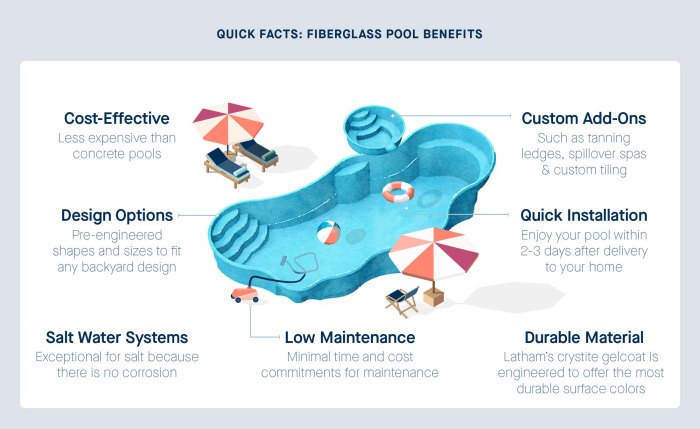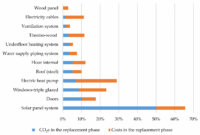Comparing concrete vs fiberglass vs vinyl liner swimming pools reveals a fascinating array of choices for homeowners. Each pool type offers a unique blend of upfront costs, long-term maintenance needs, design flexibility, and overall lifespan. Understanding these differences is crucial for making an informed decision that aligns with your budget, lifestyle, and aesthetic preferences. This comparison will delve into the specifics of each type, helping you navigate the complexities of pool ownership.
Initial Costs Comparison
Choosing a pool type involves significant upfront investment. Understanding the cost breakdown for concrete, fiberglass, and vinyl liner pools is crucial for budgeting and planning. This section compares the initial costs, encompassing materials, labor, and permitting fees for each type. Remember that these are estimates, and actual costs can vary widely based on location, pool size, and desired features.
Cost Breakdown by Pool Type
The initial cost of a swimming pool is significantly impacted by the material chosen. Below is a table summarizing estimated costs, keeping in mind that these are broad ranges and your actual costs may vary.
| Pool Type | Material Costs | Labor Costs | Total Estimated Cost |
|---|---|---|---|
| Concrete | $15,000 – $40,000+ | $10,000 – $30,000+ | $25,000 – $70,000+ |
| Fiberglass | $10,000 – $25,000 | $5,000 – $15,000 | $15,000 – $40,000 |
| Vinyl Liner | $5,000 – $15,000 | $5,000 – $10,000 | $10,000 – $25,000 |
Note: Material costs include the pool shell (concrete, fiberglass, or liner), coping, decking materials (concrete, pavers, etc.), and basic plumbing and filtration systems. Labor costs encompass excavation, installation, and finishing work. Permitting fees vary greatly by location and are not included in these estimates. Costs can increase dramatically with added features like waterfalls, spas, or intricate decking.
Typical Price Ranges for Different Pool Sizes and Features
The price range for each pool type is heavily influenced by size and added features. A small, basic pool will cost significantly less than a large pool with elaborate features.
Below are some typical price ranges for each pool type, categorized by size and complexity. These are broad estimates, and actual costs will vary based on your specific location, chosen materials, and desired features.
- Concrete Pools:
- Low: $25,000 – $40,000 (small, basic design)
- Medium: $40,000 – $70,000 (medium size, some added features)
- High: $70,000+ (large, custom design, extensive features)
- Fiberglass Pools:
- Low: $15,000 – $25,000 (smaller pre-made shell, basic installation)
- Medium: $25,000 – $40,000 (larger pre-made shell, some added features)
- High: $40,000+ (larger shell, extensive landscaping and decking)
- Vinyl Liner Pools:
- Low: $10,000 – $15,000 (small, basic design)
- Medium: $15,000 – $25,000 (medium size, some added features)
- High: $25,000+ (larger pool, custom liner design, enhanced features)
Long-Term Maintenance and Repair
Choosing a pool involves understanding the long-term commitment. While initial costs are a significant factor, the ongoing maintenance and potential repair expenses over the pool’s lifespan significantly impact the overall cost of ownership. This section compares the maintenance and repair needs of concrete, fiberglass, and vinyl liner pools over a 10-year period.
Maintenance and Repair Cost Comparison
Regular maintenance is crucial for all pool types to extend their lifespan and prevent costly repairs. The frequency and type of maintenance, however, vary significantly. Concrete pools generally require more hands-on maintenance, while fiberglass and vinyl liner pools offer lower maintenance needs, but still require attention. Ignoring regular upkeep will lead to more extensive and expensive repairs for any pool type.
| Maintenance Task | Concrete Pool (Frequency/Cost) | Fiberglass Pool (Frequency/Cost) | Vinyl Liner Pool (Frequency/Cost) |
|---|---|---|---|
| Cleaning (pump, filter, skimmer) | Weekly/ $50 – $100 per year (materials and labor, if hiring) | Weekly/ $25 – $75 per year (materials and labor, if hiring) | Weekly/ $25 – $75 per year (materials and labor, if hiring) |
| Chemical Balancing | Weekly/ $100 – $200 per year (chemicals) | Weekly/ $75 – $150 per year (chemicals) | Weekly/ $75 – $150 per year (chemicals) |
| Surface Cleaning | Monthly/ $50 – $150 per year (brushes, cleaning solutions) | Monthly/ $25 – $50 per year (brushes, cleaning solutions) | Monthly/ $25 – $50 per year (brushes, cleaning solutions) |
| Resurfacing/Refinishing | Every 5-15 years/ $5,000 – $15,000 | Generally not needed, unless significantly damaged/ Cost varies greatly depending on damage | Liner Replacement every 5-9 years/ $2,000 – $5,000 |
| Structural Repairs (cracks, leaks) | Occasional, cost varies greatly depending on severity/ $500 – $10,000+ | Rare, typically due to significant impact damage/ $1,000 – $5,000+ | Minor repairs are relatively inexpensive, major issues require liner replacement. / $100 – $5000+ |
Note: These are estimates and actual costs may vary depending on location, pool size, and specific circumstances. Hiring professionals will increase costs significantly.
Pool Lifespan and Factors Affecting Longevity
The lifespan of each pool type varies, influenced by several factors including the quality of construction, maintenance practices, and environmental conditions.Concrete pools, with proper maintenance, can last for 50 years or more. However, neglect can lead to cracking, scaling, and staining, requiring costly repairs or even premature replacement. For example, a poorly constructed concrete pool might develop structural cracks within 10 years, necessitating expensive repairs exceeding $5,000.
Extreme weather conditions, like freeze-thaw cycles in colder climates, can also significantly impact a concrete pool’s longevity.Fiberglass pools are known for their durability and typically last 25-30 years or longer. Their one-piece construction makes them less susceptible to cracking or leaks. However, damage from impacts (such as dropped objects or tree branches) or improper installation can shorten their lifespan.
A large crack or significant damage to the shell might require extensive and costly repairs or even replacement, potentially exceeding $10,000.Vinyl liner pools generally have the shortest lifespan, with liners needing replacement every 5-9 years. The lifespan of the pool shell itself is longer (20-30 years), but the recurring liner replacement costs are a significant factor to consider.
Excessive sun exposure, chemical imbalances, and punctures can all lead to premature liner failure. A liner replacement can cost between $2,000 and $5,000, depending on the size and type of liner.
Design Flexibility and Customization Options: Comparing Concrete Vs Fiberglass Vs Vinyl Liner Swimming Pools
Choosing a pool type significantly impacts the design possibilities for your backyard oasis. While all three – concrete, fiberglass, and vinyl liner – offer appealing aesthetics, their inherent properties lead to distinct limitations and advantages in terms of shape, size, and customization. Understanding these differences is crucial for realizing your dream pool.Concrete pools, for example, boast unparalleled design flexibility.
Fiberglass pools, on the other hand, offer a more limited range of pre-manufactured shapes and sizes. Vinyl liner pools, while offering some customization, are generally restricted by the size and shape of the liner itself.
Shape and Size Options
The shape and size of your pool are foundational design elements. Concrete pools provide the most freedom in this area, allowing for virtually any shape and size imaginable, from freeform designs with curves and irregular edges to geometric shapes with precise angles. This flexibility extends to pool depth, which can vary considerably within a single pool. Fiberglass pools, conversely, come in pre-determined shapes and sizes, typically offering a range of common designs like kidney, rectangular, and freeform options, but with less variation than concrete.
Vinyl liner pools share similar limitations to fiberglass, although the liner itself can sometimes be customized to fit unique pool shells.
- Concrete: Virtually unlimited shape and size options. Complex designs, varying depths, and unique features are readily achievable.
- Fiberglass: Limited to pre-manufactured molds. Shapes and sizes are predetermined, offering less flexibility.
- Vinyl Liner: Shape and size are primarily determined by the pool shell, with some minor adjustments possible through liner customization.
Customization Options: Finishes, Coping, Decking, and Water Features
Beyond the basic shape and size, numerous customization options further personalize your pool. These include finishes, coping, decking materials, and water features. Concrete pools shine here, allowing for a wide array of finishes like pebble tec, quartz, and plaster, each with a unique texture and appearance. Coping options, such as tile, stone, or concrete, also contribute significantly to the overall aesthetic.
Decking choices range from concrete and pavers to wood and composite materials. Water features like waterfalls, jets, and tanning ledges can be seamlessly integrated into the concrete structure.Fiberglass pools offer fewer customization options in terms of finishes, typically limited to the gel coat finish provided by the manufacturer. Coping and decking choices are largely independent of the pool shell itself, offering some degree of personalization.
Water features are usually limited to those that can be added post-installation, potentially reducing design integration.Vinyl liner pools offer a limited range of liner patterns and colors, providing a degree of personalization. Coping and decking are independent choices, similar to fiberglass pools. Water features are generally added after installation, potentially affecting aesthetic cohesion.
- Concrete: Extensive customization with various finishes (pebble, quartz, plaster), coping (tile, stone, concrete), decking (concrete, pavers, wood), and integrated water features (waterfalls, jets, tanning ledges).
- Fiberglass: Limited finish choices (gel coat), independent coping and decking options, water features usually added post-installation.
- Vinyl Liner: Limited liner pattern and color choices, independent coping and decking options, water features usually added post-installation.
Installation Process and Timeline
Choosing the right pool type significantly impacts the installation process and the overall project timeline. Each type—concrete, fiberglass, and vinyl liner—presents unique challenges and advantages in terms of time commitment and labor intensity. Understanding these differences is crucial for realistic project planning and budgeting.The installation process for each pool type involves several distinct steps, with varying durations and potential complications.
Factors such as site preparation, weather conditions, and the availability of skilled labor can influence the overall timeline.
Concrete Pool Installation
| Pool Type | Installation Steps | Timeline | Potential Challenges |
|---|---|---|---|
| Concrete | 1. Site preparation (excavation, grading, utilities); 2. Steel reinforcement installation; 3. Gunite or shotcrete application; 4. Curing and finishing; 5. Plumbing and electrical installation; 6. Tile and coping installation; 7. Plaster or pebble finish application; 8. Deck construction. | 8-12 weeks (or longer, depending on weather and site conditions). | Unexpected site conditions (e.g., rock formations), weather delays, skilled labor shortages, and potential issues with curing the concrete. |
Fiberglass Pool Installation
| Pool Type | Installation Steps | Timeline | Potential Challenges |
|---|---|---|---|
| Fiberglass | 1. Site preparation (excavation, grading, utilities); 2. Pool shell placement (requires heavy equipment); 3. Plumbing and electrical connections; 4. Backfilling and compaction; 5. Coping and decking installation. | 4-6 weeks (significantly faster than concrete). | Precise site preparation is crucial to ensure a proper fit for the pre-fabricated shell. Difficult access to the site can increase installation time and costs. |
Vinyl Liner Pool Installation
| Pool Type | Installation Steps | Timeline | Potential Challenges |
|---|---|---|---|
| Vinyl Liner | 1. Site preparation (excavation, grading, utilities); 2. Wall construction (typically using pre-fabricated panels or blocks); 3. Liner installation; 4. Plumbing and electrical connections; 5. Coping and decking installation. | 2-4 weeks (generally the fastest installation). | Proper wall construction and liner installation are critical to prevent leaks. Wrinkles or damage to the liner during installation can lead to delays and repairs. |
Energy Efficiency and Water Conservation
Choosing a pool type significantly impacts your long-term energy consumption and water usage. Understanding the energy efficiency and water conservation aspects of concrete, fiberglass, and vinyl liner pools is crucial for making an informed decision that aligns with your budget and environmental consciousness. Factors such as pool size, climate, and the chosen heating and filtration systems all play a role.The following sections detail the energy efficiency and water conservation characteristics of each pool type, along with strategies for improvement.
Concrete Pool Energy Efficiency and Water Conservation
Concrete pools, while offering significant design flexibility, can present challenges regarding energy efficiency and water conservation if not properly managed.
- Heating: Concrete pools tend to lose heat more quickly than other pool types due to their porous nature. This necessitates more energy for heating, especially in colder climates. Efficient heating systems, such as heat pumps, are essential to mitigate this.
- Filtration: The large surface area of a concrete pool can increase the demand on the filtration system, leading to higher energy consumption. Regular cleaning and maintenance, along with efficient pump selection, are crucial for optimal energy use.
- Water Conservation: Concrete pools can experience water loss through evaporation, especially in hotter, drier climates. Using a pool cover significantly reduces evaporation, conserving water and lowering heating costs.
Concrete Pool Energy Efficiency Improvements
Several strategies can enhance the energy efficiency and water conservation of concrete pools.
- Invest in a high-efficiency heat pump: Heat pumps transfer heat from the air to the water, using significantly less energy than gas or electric heaters.
- Use a solar pool cover: Solar covers trap heat during the day, reducing the need for heating and minimizing evaporation.
- Install a variable-speed pump: Variable-speed pumps allow for customized flow rates, optimizing filtration efficiency and reducing energy consumption.
- Regular maintenance: Proper cleaning and maintenance prevent leaks and ensure efficient operation of the filtration system.
Fiberglass Pool Energy Efficiency and Water Conservation
Fiberglass pools are generally considered more energy-efficient than concrete pools. Their non-porous surface minimizes water loss and heat dissipation.
- Heating: Fiberglass pools retain heat better than concrete pools, reducing the energy needed for heating. However, the energy efficiency still depends on the chosen heating system.
- Filtration: The smooth surface of a fiberglass pool reduces friction, leading to lower energy consumption for the filtration system compared to concrete.
- Water Conservation: The non-porous nature of fiberglass minimizes water loss through evaporation. The use of a pool cover further enhances water conservation.
Fiberglass Pool Energy Efficiency Improvements
While fiberglass pools are naturally more energy-efficient, further improvements can be made.
- Choose a heat pump: Even though fiberglass retains heat better, a heat pump remains a highly efficient heating option.
- Use a pool cover: A cover minimizes evaporation and heat loss, regardless of the pool material.
- Optimize filtration cycles: Adjust the filtration system to run only when needed, reducing unnecessary energy consumption.
Vinyl Liner Pool Energy Efficiency and Water Conservation
Vinyl liner pools offer a balance between cost and energy efficiency. While not as efficient as fiberglass, they are generally better than concrete in terms of heat retention and water conservation.
- Heating: Vinyl liner pools have moderate heat retention capabilities. The efficiency of the heating system plays a crucial role in overall energy consumption.
- Filtration: The smooth surface of the liner reduces friction, resulting in relatively lower energy consumption for filtration compared to concrete pools.
- Water Conservation: Water loss through evaporation is relatively low, especially with a pool cover.
Vinyl Liner Pool Energy Efficiency Improvements
Improving the energy efficiency of a vinyl liner pool focuses on optimizing the existing systems.
- Select an energy-efficient pump and heater: Choosing high-efficiency models minimizes energy consumption.
- Regularly inspect and maintain the liner: Leaks can significantly impact water conservation and increase heating costs.
- Use a pool cover: A pool cover is essential for minimizing evaporation and heat loss.
Resale Value and Long-Term Investment

Source: lathampool.com
Choosing a pool type significantly impacts your home’s value and your long-term investment. While all pools add desirability, the perceived value and maintenance costs vary considerably between concrete, fiberglass, and vinyl liner pools. Understanding these differences is crucial for making an informed decision that aligns with your financial goals and lifestyle.Potential buyers often assess a pool’s condition and the anticipated upkeep costs.
A well-maintained pool, regardless of material, is a significant selling point. However, the initial investment, longevity, and ease of maintenance play a substantial role in determining the overall return on investment.
Resale Value Comparison, Comparing concrete vs fiberglass vs vinyl liner swimming pools
The perceived value of each pool type to potential buyers is influenced by several factors, including the pool’s age, condition, size, and features. Concrete pools, known for their durability and customization options, often command a higher resale value, especially if they are well-maintained and feature attractive design elements. Fiberglass pools, being relatively low-maintenance, can also positively impact resale value, particularly for buyers seeking a hassle-free ownership experience.
Vinyl liner pools, while generally the most affordable upfront, may not add as much value to a home’s resale price as concrete or fiberglass, due to the need for liner replacements every 5-9 years. Their perceived lifespan can influence a buyer’s perception of long-term value.
- Concrete Pools: Pros – High perceived value, design flexibility, potential for increased home value; Cons – Higher initial cost, potential for more extensive and costly repairs over time.
- Fiberglass Pools: Pros – Moderate initial cost, relatively low maintenance, generally good resale value; Cons – Less design flexibility compared to concrete, potential for damage that may be difficult to repair.
- Vinyl Liner Pools: Pros – Lowest initial cost, relatively easy to repair (liner replacement), readily available; Cons – Liner replacement required every 5-9 years adding to long-term costs, lower perceived value compared to concrete or fiberglass.
Long-Term Return on Investment
Calculating the long-term ROI for each pool type requires considering the initial investment, annual maintenance expenses, and the expected lifespan. A concrete pool, despite its higher upfront cost, generally boasts a longer lifespan (50+ years) with proper maintenance, leading to a potentially higher ROI over the decades. Fiberglass pools, with a lifespan typically ranging from 20-30 years, offer a moderate ROI due to their lower initial cost and relatively low maintenance.
Vinyl liner pools, with their lower initial investment, have the lowest ROI due to the recurring cost of liner replacements. However, for buyers prioritizing affordability, the lower initial cost may be a significant factor outweighing the lower long-term ROI.For example, let’s consider a scenario where a homeowner is comparing a $50,000 concrete pool, a $30,000 fiberglass pool, and a $15,000 vinyl liner pool.
Over 20 years, the concrete pool might require $10,000 in repairs, the fiberglass pool $5,000, and the vinyl liner pool $10,000 in liner replacements. While the concrete pool had the highest initial cost, its lower overall maintenance costs could result in a higher overall ROI. However, a buyer might find the fiberglass pool a better option due to the lower total cost, even if it has a slightly lower ROI.
The vinyl liner pool’s low initial cost might be appealing, but the cost of multiple liner replacements over 20 years diminishes its overall return.
Closing Summary
Ultimately, the best swimming pool type depends entirely on individual priorities. Concrete pools offer unparalleled customization, while fiberglass pools boast faster installation and lower maintenance. Vinyl liner pools present an affordable entry point with reasonable upkeep. By carefully weighing the initial investment, long-term costs, desired aesthetics, and your personal preferences, you can confidently select the pool that perfectly complements your home and lifestyle for years to come.
General Inquiries
What is the average lifespan of each pool type?
Concrete pools can last 50+ years with proper maintenance. Fiberglass pools typically last 25-30 years. Vinyl liner pools require liner replacements every 5-9 years, but the shell can last much longer.
Can I add features later to my pool, regardless of the type?
Adding features is easiest with concrete pools due to their customizable nature. Fiberglass and vinyl liner pools offer limited retrofitting options.
How much does pool heating cost?
Heating costs vary widely based on climate, pool size, and heating system. However, larger pools and colder climates will generally incur higher heating expenses regardless of pool type.
What are the common causes of pool leaks?
Leaks can stem from cracks (concrete), liner punctures (vinyl), or compromised fittings in all pool types. Regular inspections are crucial for early detection.
Which pool type is best for irregular shaped lots?
Concrete pools offer the greatest flexibility for irregular shapes. Fiberglass pools are more limited in shape options, while vinyl liner pools can adapt somewhat, but may require more custom work.



